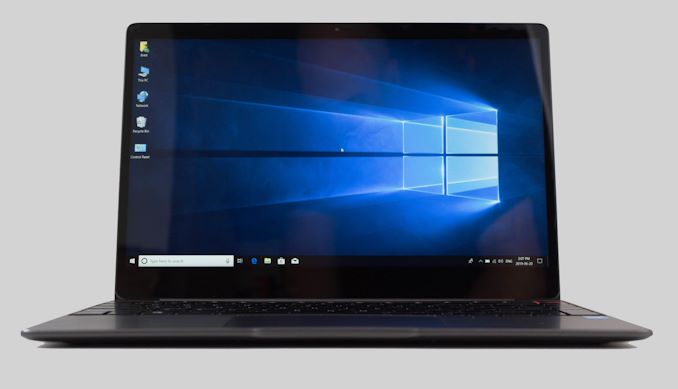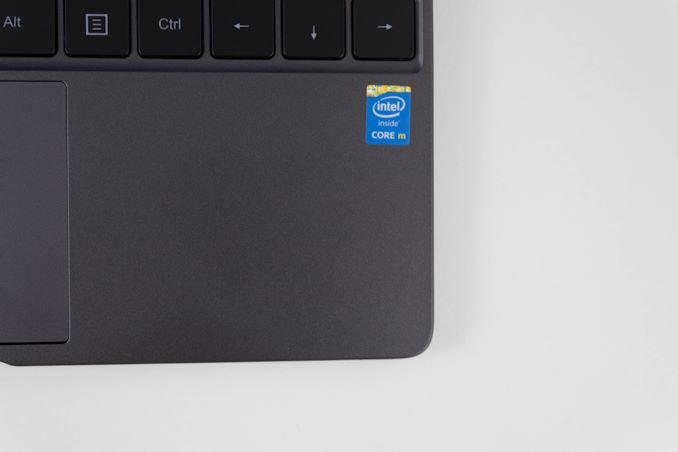The Chuwi AeroBook Review: One Small Step For Chuwi
by Brett Howse on June 21, 2019 8:00 AM EST
For the last several years, Chuwi has been shaking up the bottom end of the PC market with low-cost alternatives to the big manufacturers that offer significantly more PC for the money than you’d typically see. But, until this year, Chuwi has focused only on the lowest cost notebooks. Their signature over the last couple of years has been more RAM, more storage, and a better display than most other notebooks in their price range, making them an easy recommendation in the value end of the spectrum. Today we are taking a look at the latest notebook from Chuwi, the AeroBook, and here Chuwi has deviated from their norms. Luckily these risks all result in a better user experience, but of course it comes with tradeoffs.
The 13.3-inch Chuwi AeroBook is the first notebook from the company to not use an Atom based processor, with the AeroBook making the leap to an Intel Core based CPU in the Core m3-6Y30. This is a Skylake-Y series CPU, meaning this isn’t the latest generation Amber Lake-Y we just took a look at in the HP Spectre Folio – or even the previous generation Kaby Lake-Y – but a generation farther back still. So even though it’s a step up to Core, it’s not a giant leap. The Core m3-6Y30 offers two Skylake CPUs cores with Hyperthreading, and a base frequency of 900 MHz with a maximum turbo frequency of 2.2 GHz. Compared to the latest Core m3-8100Y, it’s well behind the 1.1-3.4 GHz range that CPU can achieve, but regardless, it’s still a nice step over the previous Atom based Chuwi LapBooks we’ve reviewed.
As a budget device, you’d likely expect budget specifications, but Chuwi, as usual, offers quite a bit of value in the AeroBook. The version sold in North America comes with 8 GB of RAM and a 256 GB SSD, meaning it’s well-equipped for an Ultrabook with a price of just $499.00 USD. For comparison, that’s twice the storage as the same priced Surface Go, and you don’t need to purchase a keyboard for this laptop either. As a budget device though, there’s always going to be compromise, and that happens here with the RAM being single-channel only, and the SSD being a M.2 SATA version. But it does pair nicely with the Core m3, offering enough RAM and storage to make the system usable for many tasks.
Chuwi also continues to offer an IPS display, and while that is a standout feature on their lower cost devices, once they bump into higher price brackets, it’s no longer the rarity that it is at the $250 range.
| Chuwi AeroBook | |||||
| Specifications | |||||
| CPU | Intel Core m3-6Y30 2C / 4T 900 MHz - 2.2 GHz 4.5 W TDP |
||||
| GPU | Intel HD 515 24 EU 300-850 MHz |
||||
| Display | 13.3-inch 1920x1080 IPS Glossy No Touch |
||||
| Storage | 256 GB SSD Netec SATA M.2 |
||||
| Wireless | Intel Dual Band Wireless AC-3165 1x1 802.11ac with Bluetooth |
||||
| I/O | 2 x USB 3.0 1 x USB Type-C w/PD 1 x Micro HDMI Micro SD 3.5mm headset jack |
||||
| Webcam | 2.0 MP | ||||
| Battery | 38 Wh Li-Ion 24 W AC Adapter |
||||
| Dimensions | 308 x 209 x 15.2 mm 12.1 x 8.2 x 0.6 inches |
||||
| Weight | 1.26 Kg / 2.77 lbs | ||||
| MSRP | $499 USD | ||||
To hit the lower price ranges while still offering reasonable baseline specifications, other portions of the laptop do take a hit, as you’d expect. Chuwi offers only 1x1 Wi-Fi, but it is the Intel Dual Band Wireless-AC 3165 NIC, so despite being a 1x1 NIC, it’s still a quality one. Chuwi also only offers a 38 Wh battery, which is certainly on the small side for a 13.3-inch notebook.
With a new notebook lineup, and the jump to Core, Chuwi has bumped their price bracket up slightly, but they are still offering the value you’d expect. Let’s dig into how the rest of the notebook fares, starting with the design.











51 Comments
View All Comments
bubblyboo - Friday, June 21, 2019 - link
US-warranty vs no warranty is also pretty unfair.nandnandnand - Sunday, June 23, 2019 - link
Marlin and levizx are right. The sucker price is for suckers. There's something on sale in any given category at any moment. Go back a year or two and the main difference in a laptop will be the specific CPUs and GPUs, so judge price/perf accordingly.systemBuilder - Friday, July 19, 2019 - link
You can think of the "m" series of processors as "bringing the Atom Slowness to the Pentium Line of CPUs". In other words, when you spend 90% of your life thermally throttled because the device is stupid-thin AND stupid-light, you suffer a great deal... I prefer my Acer Chromebook c720 i3.Urthor - Saturday, June 22, 2019 - link
You have to understand the pressure that Intel puts on sellers with the prices of its CPUs to OEM'sSecondhand laptops have been FAR cheaper for a LOT longer because ultimately Intel's control of the key part stops them discounting.
mkozakewich - Friday, June 21, 2019 - link
Chuwi are a cheap manufacturer that have been known to ship cheap parts that fail, and they won't respond to warranty requests unless you can post a video to YouTube (seriously, what) showing some kind of physical damage.yeeeeman - Friday, June 21, 2019 - link
For 250$, maybe, but for 500...no wayabufrejoval - Friday, June 21, 2019 - link
I got the Lapbook 12.3 after the review here.The main attraction was the high-resolution (3k) screen and totally silent operation for e-books and surfing. And while my first unit had a defective space-bar and completely unusable touchpad (way too sensitive), the second one was rather better with both, and delivered on the performance and usability criteria.
I moved Windows 10 immediately to a 128GB M.2 SSD and then put a Ubuntu 18.04 on the eMMC, mostly because I needed a little more space anyway and to avoid slowing the machine via the storage.
The disappointment came when I unpacked the ChuWi in the hotel after a flight and found it all bent out of shape from a battery that had gassed out, because a replacement battery cannot be bought from anyone or anywhere: ChuWi simply does not sell spare parts.
It’s easy enough to replace, a couple of screws and unplugging a connector, but without a spare part, it’s life is essentially ended before a year is full.
After a bit of howling and screaming they did offer me to send it to HongKong for a free replacement, and I am torn between using it just on external power or actually see if it gets back fixed.
I’m not sure I can attribute the battery failure to a quality defect on their side, though.
It’s the second time the very same thing happened to me and the other one was a Gigabyte mobile workstation at 10x the price (no issue with the spare parts there).
I believe the fault actually lies with Windows.
When I hibernate a notebook, I expect it to stay powered off until I power it up again. But Windows these days has so much AI, it knows better and seems to wake up hibernated (not just suspended) machines for things like regular reports to Redmont.
Since some of my machines are configured to actually boot Ubuntu, CentOS or Fedora by default, that is especially useless, because the Windows induced wakeup has them boot an OS that didn’t even ask for that.
In the confines of rucksack in an overhead locker then, these machines can easily overheat and cook the batteries until they’re dead.
I have tried very hard to find a recipe to keep these wakeups from happening. I really do like the ability to keep documents and VMs open (and hibernated on SSD), while I travel.
So far the only way to avoid these wakeups, seems to be removing the power supply before hibernating the machines: At that point “hibernate” seems to be actually understood by Microsoft as meaning “don’t wake automagically so you don’t fry batteries by accident in an airplane”.
I have started using that approach on commutes, but for longer trips, I do shut down those laptops, because the risk of unwarranted wakeups is too high.
So there you have it: ChuWis don’t disappoint as hardware per se, but spare parts or service are not included at this price.
olafgarten - Friday, June 21, 2019 - link
Windows doesn't wake hibernated laptops unless some hardware connected to it issues a wakeup signal. You either accidentally hit the on button or you have a faulty keyboard wakeup key.Also if you are using Ubuntu as the main OS, you are probably booting into Grub and so Windows has no control over the wakeup.
abufrejoval - Friday, June 21, 2019 - link
And so would I have sworn, perhaps not on my life, but at least a case of beer...I was far more inclined to blame the flying or even the security scanners at the airport.
Yet major problems there would be hard to hide...
And then I got a Lenovo S730 ultrabook to replace it and observed it for days.
Hibernated it (hybrid disabled) and was very surprised to watch it power up and boot whatever happend to be configured as primary in the BIOS, ... and that changed between Windows 10 1903 and Fedora 30, depending on what was more frequently used.
Mind you, I disconnected all external devices, nothing and nobody touching it, the power button requires quite a bit of force to exercise, but within half an hour to a full one it would power on again.
Now, I am pretty sure, that nobody in my network sends magic packets or patterns, and in any case I disabled that too, but no change. There are dozens of jobs scheduled in Windows and I deleted quite a few of those, mostly the "calling home" type. Also stopped and disabled the "user experience service" etc.
But so far the only thing that changed the behavior was to change the unplugging and the hibernate sequence: With the power plugged in at hibernate, Windows seems to assume it's ok to run scheduled jobs. Without external power, "hibernate" is "hibernate".
And these days, when you say "shut down" on Windows, you have to uncheck a hidden option in Windows to actually *make* it shut-down. Otherwise it will be 'smart' enough to assume that restarting Windows more quickly is more important and interpret "shutdown" as suspend-with-fast-restart...
And I have seen similar behavior in desktops that were *suspended* to RAM, with all magic packets and PS/2 as well as USB events disabled in BIOS to cause power up.
On those systems, massive amounts of RAM and SATA SSDs made hibernation less attractive and standby seemed a good compromise...
Here on the Lenovo RAM is stuck as 16GB and the NVMe will restore RAM at 3GB/s...
But "wakeup2die" isn't really attractive.
Perhaps we could get a little more end-user data on this?
Mil0 - Sunday, June 23, 2019 - link
I've seen this behavior as well, using MSI/Acer laptops, so it's not limited to some manufacturers.Thanks for the no-power-when-hibernating trick, I'll use that from now on.
It's a bit silly that there is no thermal protection on the battery - should be a pretty easy/cheap fix.